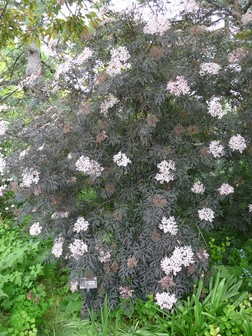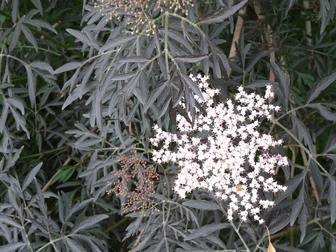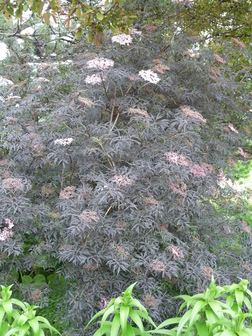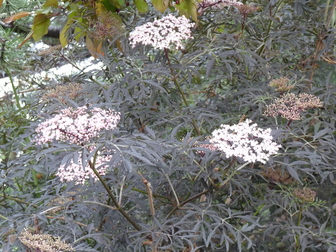Back to Tour: Medicinal Plants Tour
|
Sambucus nigra 'Eva' BLACK LACE® Black Elder; European Elder |
Denver Botanic Gardens
Gardens Navigator 
|
|
Accession Number: 061620*1 Map | Images | |
| More about Sambucus nigra 'Eva' BLACK LACE® | |
| TOUR DETAILS |
Medicinal uses: Elderberries are rich in antioxidants and are antiviral. They also have mildly laxative properties. The berries or seeds should not be eaten raw as they contain a bitter form of cyanide called sambucins. The berries of elder are especially good for colds and coughs and can be made into syrup or wine. The flowers are made into cordial or tea. Cold elder-flower tea can also be applied to the eyes to soothe irritation. The leaves of elder help with bruising, sores or wounds on skin. Mythology/Folklore: The word “elder” comes from the Anglo-Saxon “aeld” meaning “fire.” This refers to the hollow stems being used to blow fires and build them up. The Latin name Sambucus comes from the Greek “sambuca” referring to the sackbut, an ancient musical instrument made from the branches of the Elder tree. The sacredness of the elder tree made people believe it could not be hit with lightening, so it was planted by houses. Churches during the Middle Ages believed that not only had Christ been crucified on a cross made of elder wood, but that Judas Iscariot (his betrayer) had hanged himself from an elder tree. This is why one of the older nicknames for this plant was the “Judas-tree.” Because of its ties to the deaths of Christ and Judas, the elder tree has often been a symbol of death. It also has a narcotic smell to it, which some believed was the smell of death. Interestingly, no plants will grow in the shadow of this plant. Medicinal recipe: Elderflower Cordial: 4 cups water, 4 cups sugar, 30 clusters fresh elderflowers (no decaying or browning!), 2 lemons, sliced, 2 oranges, sliced, 1 ¾ ounces citric acid Bring water and sugar to a boil and allow to cool. While it is cooling, go outside and cut fresh elderflowers and shake gently to remove bugs. Bring indoors and use a fork to remove the flowers from their stems. Combine all ingredients in a large bowl, let it sit for 24 hours, stirring and tasting as necessary. After 24 hours, strain the mixture into clean jars. Store in the refrigerator for up to a month or longer in the freezer. Culture (from staff horticulturalist Angie Andrade) Sambucus is extremely easy to grow in Colorado. They thrive in full sun or part shade, are fast growing and can tolerate most soils, although they do best when composted. |
| LOCATION GROUP | Shady Lane |
| FAMILY NAME | Viburnum Family |
| FAMILY | Viburnaceae |
| ACCESSION DATE |
July 11, 2006 (When this plant was acquired and registered in the database) |
| FLOWER COLOR | pink |
| FRUIT COLOR | red |
| USDA HZ | 4 (Coldest Zone Where Hardy) |
| HABIT | Shrub |
Location Map for 061620*1 Sambucus nigra 'Eva' BLACK LACE®
Map Help
Flowering
When Sambucus nigra 'Eva' BLACK LACE® has been observed flowering at Denver Botanic Gardens
 | ||||||||||||||||||||||||||||||||||||||||||||||||||||
| 2019 |  |
 |
 |
 |
 |
 |
 |
 |
 |
 |
 |
 |
 |
 |
 |
 |
 |
 |
 |
 |
 |
 |
 |
 |
 |
 |
 |
 |
 |
 |
 |
 |
 |
 |
 |
 |
 |
 |
 |
 |
 |
 |
 |
 |
 |
 |
 |
 |
 |
 |
 |
 |
| 2017 |  |
 |
 |
 |
 |
 |
 |
 |
 |
 |
 |
 |
 |
 |
 |
 |
 |
 |
 |
 |
 |
 |
 |
 |
 |
 |
 |
 |
 |
 |
 |
 |
 |
 |
 |
 |
 |
 |
 |
 |
 |
 |
 |
 |
 |
 |
 |
 |
 |
 |
 |
 |
| 2012 |  |
 |
 |
 |
 |
 |
 |
 |
 |
 |
 |
 |
 |
 |
 |
 |
 |
 |
 |
 |
 |
 |
 |
 |
 |
 |
 |
 |
 |
 |
 |
 |
 |
 |
 |
 |
 |
 |
 |
 |
 |
 |
 |
 |
 |
 |
 |
 |
 |
 |
 |
 |
Images © Denver Botanic Gardens
 061620*1 Sambucus nigra [Black Lace] = 'Eva' |
 061620*1 Sambucus nigra [Black Lace] = 'Eva' |
 061620*1 Sambucus nigra [Black Lace] = 'Eva' |
 061620*1 Sambucus nigra [Black Lace] = 'Eva' |
 061620*1 Sambucus nigra [Black Lace] = 'Eva' |
|
| ^Top of Page |

© Denver Botanic Gardens, 1007 York Street, Denver, CO 80206
Photography © Denver Botanic Gardens

Powered by







 E-mail
E-mail